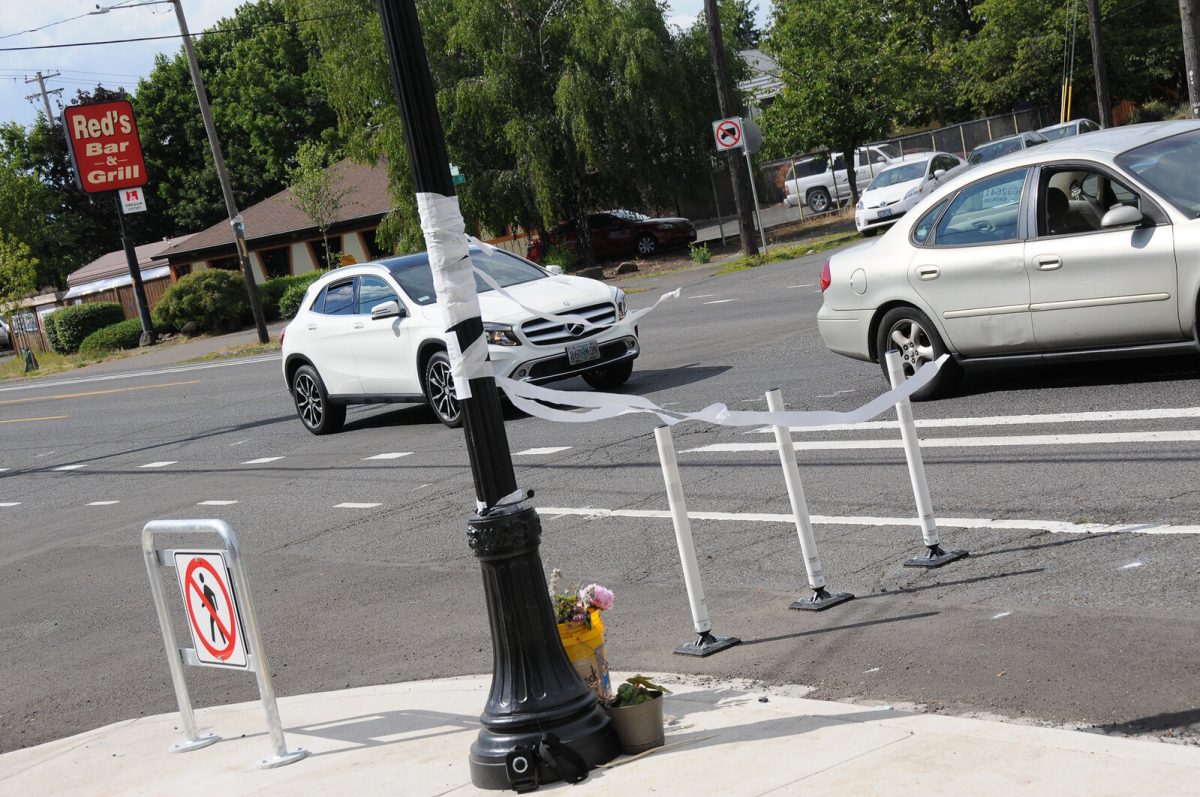
(Photo: J. Maus/BikePortland)
When I rolled up to the memorial and rally for Lou Battams on Southeast Foster Road last month, I noticed the crossing adjacent to her makeshift memorial was officially closed.
It seemed like a poke in the eye for the City of Portland to deem an intersection too dangerous for crossing just days after a woman was killed trying to walk across it.
But this isn’t the only “No Crossing” sign I’ve seen pop up recently. There are several in my neighborhood along North Rosa Parks Way and I’ve heard about more of them from readers via social media. So what’s up? Is Portland ceding our streets to the most dangerous users? If “every corner is a crosswalk” why aren’t all corners open? Why would a Vision Zero city discourage walking?
Since last fall I’ve asked the Portland Bureau of Transportation about two specific crossings that have been closed.
@BikePortland you really ought to do a piece on the proliferation of these anti-crossing signs that @PBOTinfo is currently enamored with. They’re going In all over as if improvements in one place require limitations in another. PBOT’s zero sum game? #zerovision pic.twitter.com/fJSnmxK02B
— Tony (@Tonyatwork) October 10, 2018
“PBOT is not in the pedestrian crossing closing business. We do not close crossings unless we absolutely have to.”
— John Brady, PBOT
After a reader tweeted a photo of a “No Crossing” sign at N Rosa Parks and Moore (above), I forwarded the link to PBOT Communications Director John Brady. “PBOT is not in the pedestrian crossing closing business. We do not close crossings unless we absolutely have to,” he assured me. Brady said in the case of Rosa Parks and Moore PBOT decided to install a closure sign because there’s no way to access the sidewalk on the north side of Rosa Parks in that location (it intersects with a wand-protected bike lane). If people want to cross, PBOT thinks they should walk across Moore to the other corner where there is a curb ramp on both sides of Rosa Parks. “There are also marked crosswalks at Vancouver (marked and signalized) and Williams (marked and signed) less than 300 feet away where people can cross if they feel more comfortable doing it there,” Brady wrote in an email.
As for the crossing where Lou Battams was killed. Brady assured me it was not closed because of her. “That installation [on southwest corner of Southeast 72nd and Foster] was a condition that had been placed on nearby development. They just happened to be installed right after the fatality,” he shared. Brady added that new construction triggers a crossing analysis, and if warranted, PBOT will require developers to pay for the “No Crossing” signage.
What triggers the installation of these signs? Here’s Brady’s response:
“A classic example is when, opposite a corner, there is a driveway, bioswale, parking, or a non-ADA curb—i.e. something which restricts free movement or could cause conflict if a pedestrian tried to cross. Other common situations could be where traffic volume is so great that we want to incentivize people crossing nearby where there is better traffic control (signals, stop signs, rapid-flashing beacons).”
As for the recent uptick of these signs around town, Brady said that’s simply a function of more private development and PBOT infrastructure projects coming online.
If you have a question about a specific “No Crossing” sign and want to know why it was installed, feel free to contact PBOT for more information at (503) 823-5185 or PDXroads@portlandoregon.gov.
— Jonathan Maus: (503) 706-8804, @jonathan_maus on Twitter and jonathan@bikeportland.org
Never miss a story. Sign-up for the daily BP Headlines email.
BikePortland needs your support.

